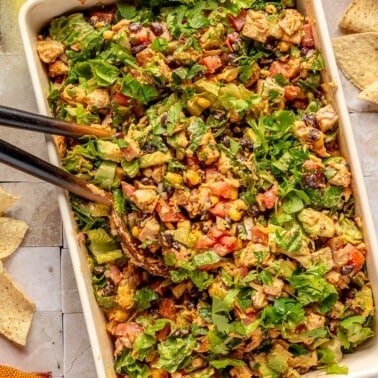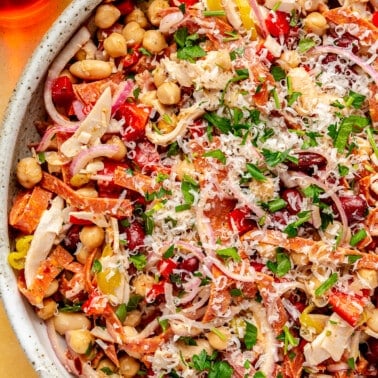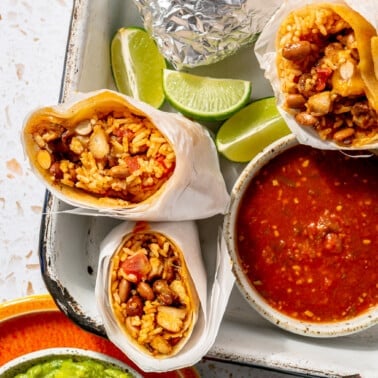Wondered if you can freeze bananas? Bell peppers? Spinach? I’m giving you the do’s and don’t’s of freezing fruits and vegetables in this comprehensive guide. I’ll let you know what foods are best consumed fresh, what can be frozen, and HOW to freeze those foods so that the texture and flavors are still quality.
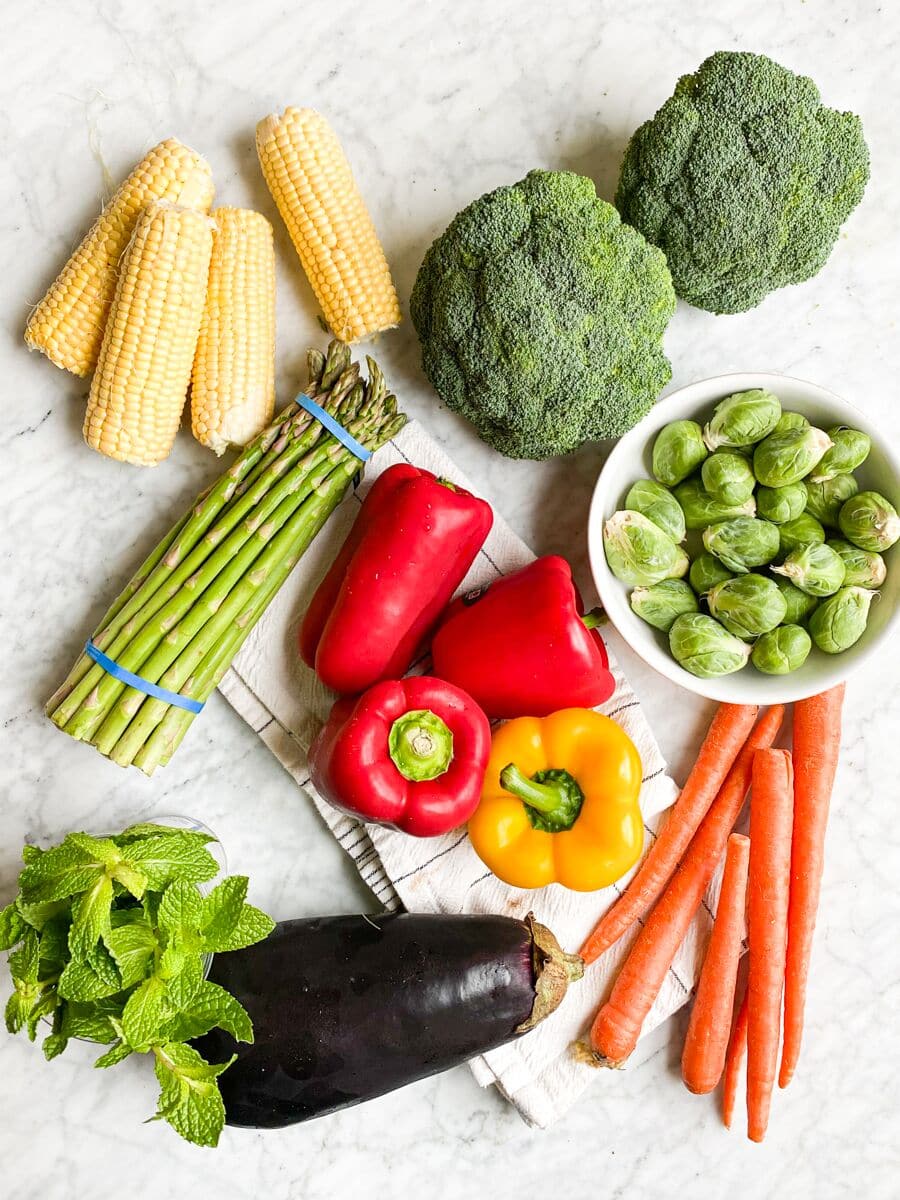
Fruits
Apples
Can you freeze fresh apples? YES.
- Apples are best frozen as a (raw) puree, cooked applesauce, or cooked apple slices (think: for plopping into an apple pie at a later date). This is because the tender flesh of an apple will wilt (or become soggy) if you freeze them in their natural state.
- Note: you can get away with freezing fresh, raw apple slices if you plan to blend them into a smoothie or use to make applesauce once defrosted. The crisp apple bite you’re used to won’t be there, though.
Avocados
Can you freeze avocados? YES.
- Avocados are best frozen scooped out of the flesh and mashed with lemon (or lime), salt, and pepper. Spoon the mash into an airtight container and make sure NO air touches the top layer.
- Note: frozen mashed avocado is best enjoyed as guacamole.
Bananas
Can you freeze bananas? YES.
- Bananas are best frozen when they’re ripe. Peel and slice the bananas into coins, lay the bananas in a single layer on a parchment-covered baking sheet to freeze for about an hour (this prevents them from freezing together in clumps), and then transfer them to a Ziploc or container of your choice. You can also freeze bananas whole (still peeled) if desired.
Blackberries
Can you freeze blackberries? YES.
- Blackberries are best frozen after being thoroughly washed and dried. Once dried, lay the blackberries in a single layer on a parchment-covered baking sheet to freeze for about an hour (this prevents them from freezing together in clumps), and then transfer them to a Ziploc or container of your choice.
Blood Oranges
Can you freeze blood oranges? YES.
- Blood oranges are best frozen either sliced (with the rind on) or in segments (no rind). Slice or segment your orange, lay the segments (skip this step if you have rind-on slices) in a single layer on a parchment-covered baking sheet to freeze for about an hour (this prevents them from freezing together in clumps), and then transfer them to a Ziploc or container of your choice.
- To freeze freshly squeezed blood orange juice, just store in an airtight container with about 1/2 inch of room at the top to allow for the juice to expand once frozen.
- Note: the longer blood oranges sit in the fridge after defrosting, the mushier they’ll get, so be sure to use them pretty quickly after thawing.
Blueberries
Can you freeze blueberries? YES.
- Blueberries are best frozen after being thoroughly washed and dried. Once dried, lay the blueberries in a single layer on a parchment-covered baking sheet to freeze for about an hour (this prevents them from freezing together in clumps), and then transfer them to a Ziploc or container of your choice.
Cherries
Can you freeze cherries? YES.
- Cherries are best frozen after being thoroughly washed, dried, and pitted. Once pitted, lay the cherries in a single layer on a parchment-covered baking sheet to freeze for about an hour (this prevents them from freezing together in clumps), and then transfer them to a Ziploc or container of your choice.
Clementines
Can you freeze clementines? YES.
- Clementines are best frozen once peeled and segmented. Once segmented, lay the clementine segments in a single layer on a parchment-covered baking sheet to freeze for about an hour (this prevents them from freezing together in clumps), and then transfer them to a Ziploc or container of your choice.
- Note: the longer clementines sit in the fridge after defrosting, the mushier they’ll get, so be sure to use them pretty quickly after thawing.
Cranberries
Can you freeze cranberries? YES.
- Cranberries are best frozen after being thoroughly washed and dried. Once dried, lay the cranberries in a single layer on a parchment-covered baking sheet to freeze for about an hour (this prevents them from freezing together in clumps), and then transfer them to a Ziploc or container of your choice.
Currants
Can you freeze currants? YES.
- Currants are best frozen rinsed and left in clusters, as they are much easier to de-stem without squishing once frozen.
Dates
Can you freeze dates? YES.
- Dates are best frozen either whole or as date paste. To freeze whole, simply transfer the dates to a freezer-safe airtight container and pop in the freezer. To make and freeze date paste, remove the pits, soften the dates in water for a couple of hours, transfer the softened dates to a food processor, puree, and then store flat in a freezer-safe baggy, breaking off pieces as you need them.
Elderberries
Can you freeze elderberries? YES.
- Elderberries are best frozen rinsed and left in clusters, as they are much easier to de-stem without squishing once frozen.
Gooseberries
Can you freeze gooseberries? YES.
- Gooseberries are best frozen after being thoroughly washed and dried. Once dried, lay the gooseberries in a single layer on a parchment-covered baking sheet to freeze for about an hour (this prevents them from freezing together in clumps), and then transfer them to a Ziploc or container of your choice.
Grapefruit
Can you freeze grapefruit? YES.
- Grapefruit is best frozen peeled and cut into segments. Once segmented, lay the grapefruit in a single layer on a parchment-covered baking sheet to freeze for about an hour (this prevents them from freezing together in clumps), and then transfer them to a Ziploc or container of your choice.
- To freeze freshly squeezed grapefruit juice, just store in an airtight container with about 1/2 inch of room at the top to allow for the juice to expand once frozen.
- Note: the longer grapefruits sit in the fridge after defrosting, the mushier they’ll get, so be sure to use them pretty quickly after thawing.
Grapes
Can you freeze grapes? YES.
- Grapes are best frozen after being thoroughly washed and dried. Once dried, lay the cranberries in a single layer on a parchment-covered baking sheet to freeze for about an hour (this prevents them from freezing together in clumps), and then transfer them to a Ziploc or container of your choice.
- Note: frozen grapes make for a yummy snack!
Key Limes
Can you freeze key limes? YES.
- Key limes are best frozen in wedges with the rind on or left whole. If slicing, lay the wedges in a single layer on a parchment-covered baking sheet to freeze for about an hour (this prevents them from freezing together in clumps), and then transfer them to a Ziploc or container of your choice. If freezing whole, pop the key limes in a bag, squeeze out as much air as you can, and stick in the freezer.
- Key lime juice can be frozen in ice cube trays, ready to pop out and be used when you’re out of fresh juice!
- Note: the longer key limes sit in the fridge after defrosting, the mushier they’ll get, so be sure to use them pretty quickly after thawing.
Kumquats
Can you freeze kumquats? YES.
- Kumquats are best frozen either whole or sliced with seeds removed. Store them in a Ziploc or container of your choice in the freezer.
Lemons
Can you freeze lemons? YES.
- Lemons are best frozen in wedges with the rind on or left whole. If slicing, lay the wedges in a single layer on a parchment-covered baking sheet to freeze for about an hour (this prevents them from freezing together in clumps), and then transfer them to a Ziploc or container of your choice. If freezing whole, pop the lemons in a bag, squeeze out as much air as you can, and stick in the freezer.
- Lemon juice can be frozen in ice cube trays, ready to pop out and be used when you’re out of fresh juice!
- Note: the longer lemons sit in the fridge after defrosting, the mushier they’ll get, so be sure to use them pretty quickly after thawing.
Limes
Can you freeze limes? YES.
- Limes are best frozen in wedges with the rind on or left whole. If slicing, lay the wedges in a single layer on a parchment-covered baking sheet to freeze for about an hour (this prevents them from freezing together in clumps), and then transfer them to a Ziploc or container of your choice. If freezing whole, pop the limes in a bag, squeeze out as much air as you can, and stick in the freezer.
- Lime juice can be frozen in ice cube trays, ready to pop out and be used when you’re out of fresh juice!
- Note: the longer limes sit in the fridge after defrosting, the mushier they’ll get, so be sure to use them pretty quickly after thawing.
Mandarin Oranges
Can you freeze mandarin oranges? YES.
- Mandarin oranges are best frozen once peeled and segmented. Once segmented, lay the mandarin orange segments in a single layer on a parchment-covered baking sheet to freeze for about an hour (this prevents them from freezing together in clumps), and then transfer them to a Ziploc or container of your choice.
- Note: the longer mandarins sit in the fridge after defrosting, the mushier they’ll get, so be sure to use them pretty quickly after thawing.
Meyer Lemons
Can you freeze Meyer lemons? YES.
- Meyer lemons are best frozen in wedges with the rind on or left whole. If slicing, lay the wedges in a single layer on a parchment-covered baking sheet to freeze for about an hour (this prevents them from freezing together in clumps), and then transfer them to a Ziploc or container of your choice. If freezing whole, pop the Meyer lemons in a bag, squeeze out as much air as you can, and stick in the freezer.
- Meyer lemon juice can be frozen in ice cube trays, ready to pop out and be used when you’re out of fresh juice!
- Note: the longer Meyer lemons sit in the fridge after defrosting, the mushier they’ll get, so be sure to use them pretty quickly after thawing.
Navel Oranges
Can you freeze navel oranges? YES.
- Navel oranges are best frozen peeled and cut into segments. Once segmented, lay the oranges in a single layer on a parchment-covered baking sheet to freeze for about an hour (this prevents them from freezing together in clumps), and then transfer them to a Ziploc or container of your choice.
- To freeze freshly squeezed orange juice, just store in an airtight container with about 1/2 inch of room at the top to allow for the juice to expand once frozen.
- Note: the longer navel oranges sit in the fridge after defrosting, the mushier they’ll get, so be sure to use them pretty quickly after thawing.
Pomegranates
Can you freeze pomegranates? YES.
- Pomegranates are best frozen in seed (aril) form. Once scooped out, lay the pomegranate arils in a single layer on a parchment-covered baking sheet to freeze for about an hour (this prevents them from freezing together in clumps), and then transfer them to a Ziploc or container of your choice.
Pomelos
Can you freeze pomelos? YES.
- Pomelos are best frozen peeled and cut into segments. Once segmented, lay the pomelos in a single layer on a parchment-covered baking sheet to freeze for about an hour (this prevents them from freezing together in clumps), and then transfer them to a Ziploc or container of your choice.
- Note: the longer pomelos sit in the fridge after defrosting, the mushier they’ll get, so be sure to use them pretty quickly after thawing.
Raspberries
Can you freeze raspberries? YES.
- Raspberries are best frozen after being thoroughly washed and dried. Once dried, lay the raspberries in a single layer on a parchment-covered baking sheet to freeze for about an hour (this prevents them from freezing together in clumps), and then transfer them to a Ziploc or container of your choice.
Strawberries
Can you freeze strawberries? YES.
- Strawberries are best frozen after being thoroughly washed, dried, and de-stemmed. Once dried and ready for the freezer, lay the strawberries in a single layer on a parchment-covered baking sheet to freeze for about an hour (this prevents them from freezing together in clumps), and then transfer them to a Ziploc or container of your choice.
- Note: you can freeze the strawberries whole or slice into halves or quarters. Either way, remove the stem first.
Tangelos
Can you freeze tangelos? YES.
- Tangelos are best frozen once peeled and segmented. Once segmented, lay the tangelo segments in a single layer on a parchment-covered baking sheet to freeze for about an hour (this prevents them from freezing together in clumps), and then transfer them to a Ziploc or container of your choice.
- Note: the longer tangelos sit in the fridge after defrosting, the mushier they’ll get, so be sure to use them pretty quickly after thawing.
Tangerines
Can you freeze tangerines? YES.
- Tangerines are best frozen once peeled and segmented. Once segmented, lay the tangerine segments in a single layer on a parchment-covered baking sheet to freeze for about an hour (this prevents them from freezing together in clumps), and then transfer them to a Ziploc or container of your choice.
- Note: the longer tangerines sit in the fridge after defrosting, the mushier they’ll get, so be sure to use them pretty quickly after thawing.
Vegetables
Acorn Squash
Can you freeze acorn squash? YES.
- Acorn squash is best frozen once cooked. Roast your acorn squash (cubed or in halves) and allow it to cool to room temperature before freezing. Once cooled, remove the skin (if roasted in halves), and either mash the acorn squash or cube it to freeze.
Arugula
Can you freeze arugula? NO.
- Arugula is best eaten ASAP. If you have a bunch that is about to go bad and you want to save it, though, you can actually turn it into a delicious pesto (just substitute arugula for spinach in this spinach pesto recipe)! Once you’ve made your pesto, you can consume it right away, or freeze for later.
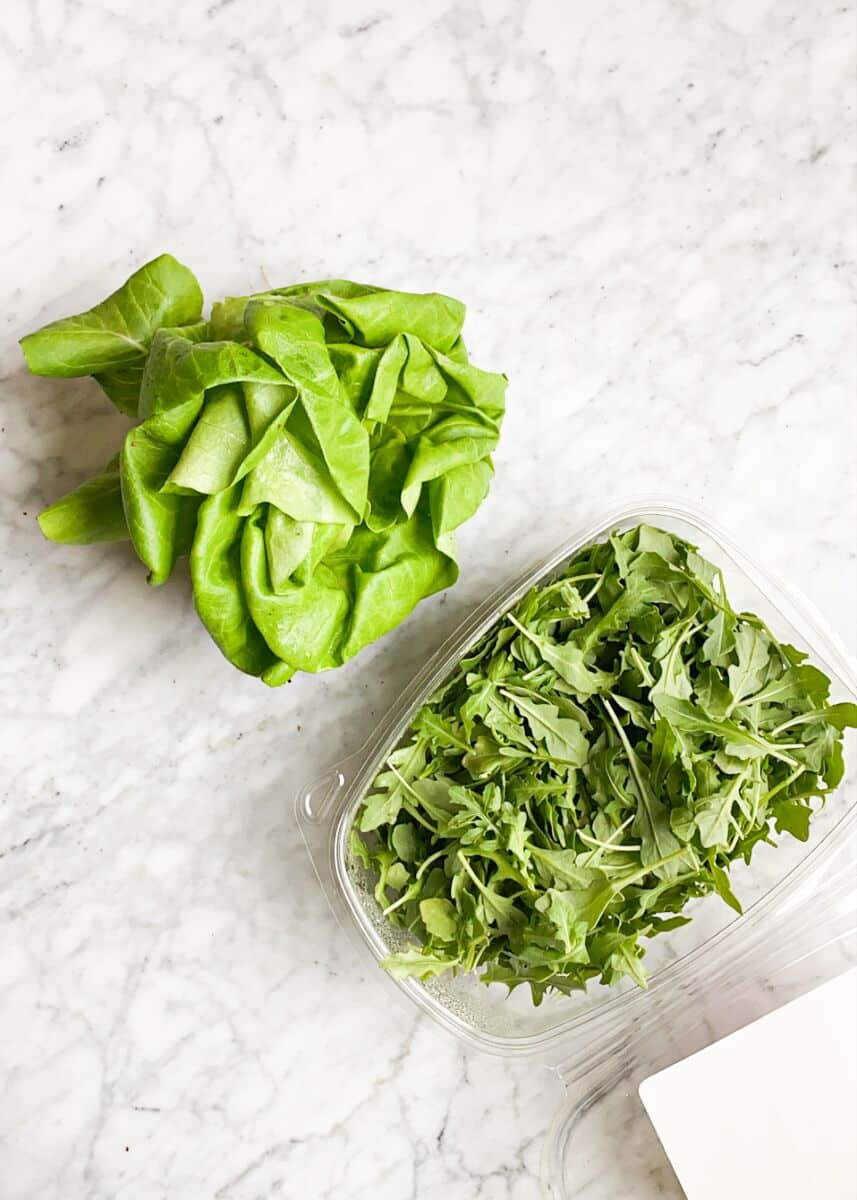
Artichokes
Can you freeze artichokes? YES.
- Artichokes are best frozen once peeled, trimmed, and cooked. Once cooked, lay the artichokes in a single layer on a parchment-covered baking sheet to freeze for about an hour (this prevents them from freezing together in clumps), and then transfer them to a Ziploc or container of your choice.
Artichoke Hearts (Canned or Jarred)
Can you freeze artichoke hearts? YES.
- Canned/jarred artichoke hearts are best frozen once drained. Lay the drained artichoke hearts in a single layer on a parchment-covered baking sheet to freeze for about an hour (this prevents them from freezing together in clumps), and then transfer them to a Ziploc or container of your choice.
- Note: the canned/jarred variety will likely be a bit mushier than fresh artichokes after defrosting, so save these for recipes (like soups and stews) where texture and appearance don’t matter.
Asparagus
Can you freeze asparagus? YES.
- Asparagus is best frozen after being blanched. Once blanched, lay the asparagus spears in a single layer on a parchment-covered baking sheet to freeze for about an hour (this prevents them from freezing together in clumps), and then transfer them to a Ziploc or container of your choice.
- Note: frozen asparagus maintains a great flavor, but can be a bit mushy once defrosted. Use frozen spears in casseroles, frittatas, and soups.
Bamboo Shoots
Can you freeze bamboo shoots? NO.
- Bamboo shoots are best eaten ASAP.
Beets
Can you freeze beets? YES.
- Beets are best frozen after either being blanched or roasted. Once cooked, store the beets, either quartered, diced, or left whole, in a heavy-duty Ziploc bag in the freezer.
Bell Peppers
Can you freeze bell peppers? YES.
- Bell peppers are best frozen after being washed, chopped, and either cooked (sauteed or roasted) or left raw.
Bok Choy
Can you freeze bok choy? YES.
- Bok choy is best frozen raw. Wash, chop, and let dry completely before freezing.
Broccoli
Can you freeze broccoli? YES.
- Broccoli is best frozen after being washed, chopped into florets, and either roasted or left raw.
Broccolini
Can you freeze broccolini? YES.
- Broccolini is best frozen after being washed, chopped, and either roasted or left raw.
Brussels Sprouts
Can you freeze Brussels sprouts? YES.
- Brussels sprouts are best frozen raw. Wash, chop, and let dry completely before freezing.

Butter (Bibb) Lettuce
Can you freeze butter lettuce? NO.
- Butter lettuce is best eaten ASAP.
Buttercup Squash
Can you freeze buttercup squash? YES.
- Buttercup squash is best frozen once cooked. Cook the squash until soft, scoop out the flesh, and freeze in an airtight container.
Butternut Squash
Can you freeze butternut squash? YES.
- Butternut squash is best frozen either cubed raw OR cooked and pureed. To freeze raw butternut squash, cube and lay the squash in a single layer on a parchment-covered baking sheet to freeze for about an hour (this prevents them from freezing together in clumps), and then transfer them to a Ziploc or container of your choice. To freeze cooked butternut squash, puree it after cooking and portion it into either muffin tins, ice cube trays, or directly onto a parchment-covered baking sheet (using a 1/2 cup measuring cup) to freeze; once completely frozen, transfer to a freezer bag for easy storage.
- Note: frozen pureed butternut squash is great for sauces, lasagna, soups, and stews.
Cabbage
Can you freeze cabbage? YES.
- Cabbage is best frozen raw. Wash, chop, and let dry completely before freezing.
Carnival Squash
Can you freeze carnival squash? YES.
- Carnival squash is best frozen once cooked. Roast your carnival squash (cubed or in halves) and allow it to cool to room temperature before freezing. Once cooled, remove the skin (if roasted in halves), and either mash the carnival squash or cube it to freeze.
Carrots
Can you freeze carrots? YES.
- Carrots are best frozen after being thoroughly washed, dried, and chopped into 1-inch pieces. Once dried, lay the chopped carrots in a single layer on a parchment-covered baking sheet to freeze for about an hour (this prevents them from freezing together in clumps), and then transfer them to a Ziploc or container of your choice.
Cauliflower
Can you freeze cauliflower? YES.
- Cauliflower is best frozen after being washed, chopped into florets, and either roasted or left raw.
Celery
Can you freeze celery? YES.
- Celery is best frozen once washed, dried, and chopped. Once dried, lay the chopped celery in a single layer on a parchment-covered baking sheet to freeze for about an hour (this prevents them from freezing together in clumps), and then transfer them to a Ziploc or container of your choice.
- Note: once defrosted, celery tends to lose its crunch. For this reason, we recommend saving frozen celery for soups and casseroles.
Collards
Can you freeze collards? YES.
- Collards are best frozen raw. Wash, chop, and let dry completely before freezing.
Cucumbers
Can you freeze cucumbers? YES.
- Cucumbers are best frozen once wash, dried, and sliced. Once dried, lay the cucumber slices in a single layer on a parchment-covered baking sheet to freeze for about an hour (this prevents them from freezing together in clumps), and then transfer them to a Ziploc or container of your choice.
Daikon
Can you freeze daikon? YES.
- Daikon is best frozen once washed, dried, chopped, and blanched. Once blanched, dry completely and transfer to a freezer-safe bag for storing.
Delicata Squash
Can you freeze delicata squash? YES.
- Delicata squash is best frozen once cooked. Cook the squash until soft, scoop out the flesh, and freeze in an airtight container.
Eggplant
Can you freeze eggplant? YES.
- Eggplant is best frozen either cubed and roasted OR blanched. Once roasted or blanched, lay the roasted cubes in a single layer on a parchment-covered baking sheet to freeze for about an hour (this prevents them from freezing together in clumps), and then transfer them to a Ziploc or container of your choice.
Fennel
Can you freeze fennel? YES.
- Fennel is best frozen either in leaves or bulbs, not whole. If freezing fennel leaves, pull the leaves from the stalk and add the leaves to an ice cube tray with a bit of water. These frozen fennel leaf cubes are great for soups and sauces. To freeze fennel bulbs, cut the leaves off, give the bulbs a quick blanch, and then freeze in a hefty freezer bag.
Fingerling Potatoes
Can you freeze fingerling potatoes? YES.
- Fingerling potatoes are best frozen after being (at least) partially cooked. Either roast or blanch chopped fingerling potatoes before freezing.
Green Beans
Can you freeze green beans? YES.
- Green beans are best frozen either cooked or raw. If you’re freezing them raw, chop the ends off of the green beans, cut them in half, and thoroughly wash before freezing. If you’re freezing cooked green beans, just transfer them to an airtight container after cooking, and freeze.
Green Peas
Can you freeze green peas? YES.
- Green peas are best frozen at least partially cooked. Shell and wash the peas, either blanch or fully cook them, and then transfer to an airtight container for storage in the freezer.
Hatch Peppers
Can you freeze hatch peppers? YES.
- Hatch peppers are best frozen after being washed, chopped, and either cooked (sauteed or roasted) or left raw.
Hearts of Palm (Canned)
Can you freeze hearts of palm? NO.
- Hearts of palm are best eaten ASAP.
Iceberg Lettuce
Can you freeze iceberg lettuce? NO.
- Iceberg lettuce is best eaten ASAP.
Jicama
Can you freeze jicama? YES.
- Jicama is best frozen whole to prevent moisture loss, preserving texture. Store whole jicama in a freezer-safe bag.
Kabocha Squash
Can you freeze kabocha squash? YES.
- Kabocha squash is best frozen once cooked. Roast your kabocha squash (cubed or in halves) and allow it to cool to room temperature before freezing. Once cooled, remove the skin (if roasted in halves), and either mash the squash or cube it to freeze.
Kale
Can you freeze kale? YES.
- Kale is best frozen raw. Wash, chop, and let dry completely before freezing.
Kohlrabi
Can you freeze kohlrabi? YES.
- Kohlrabi is best blanched quickly before freezing. Once chilled and drained, pack blanched kohlrabi into a freezer-safe bag or airtight container.
Leeks
Can you freeze leeks? YES.
- Leeks are best frozen after being thoroughly washed, dried, and chopped. Once dried, lay the chopped leeks in a single layer on a parchment-covered baking sheet to freeze for about an hour (this prevents them from freezing together in clumps), and then transfer them to a Ziploc or container of your choice.
Mushrooms
Can you freeze mushrooms? NO.
- Mushrooms are best eaten ASAP.
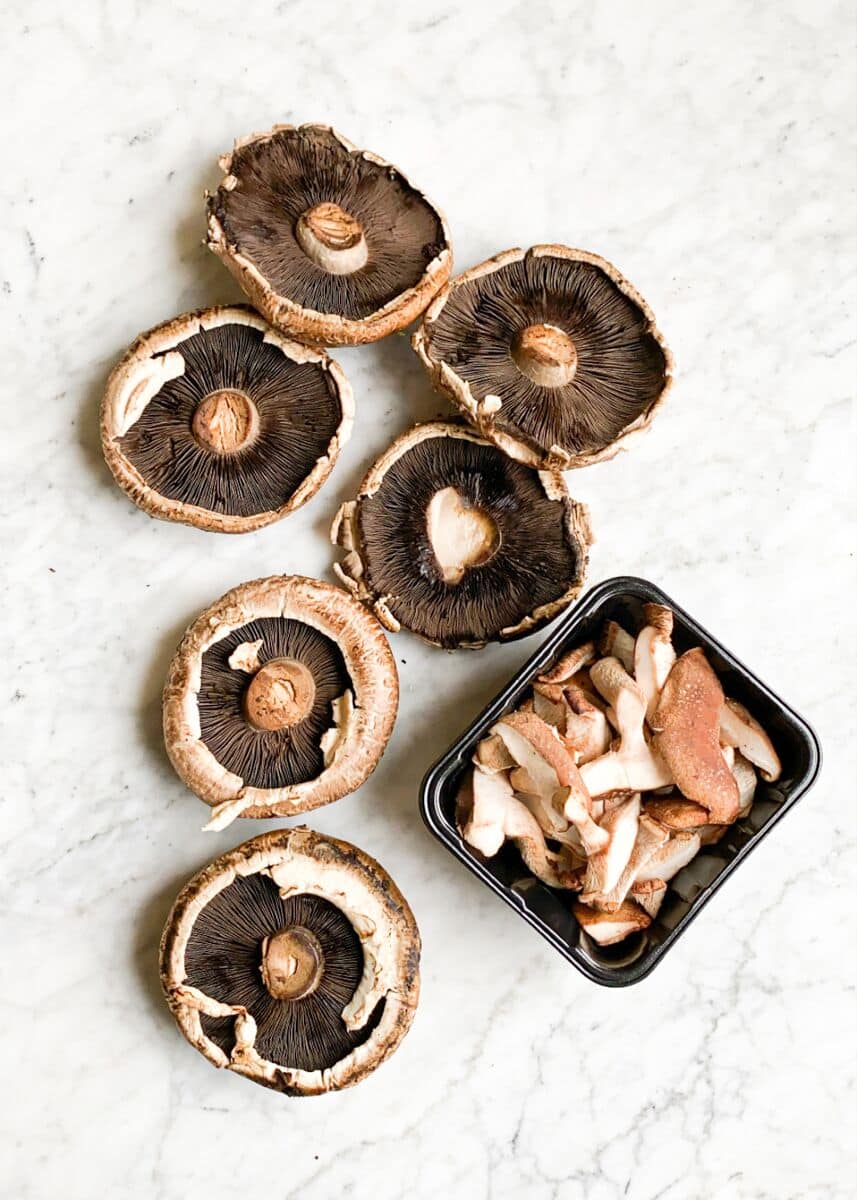
New Potatoes
Can you freeze new potatoes? YES.
- New potatoes are best frozen after being (at least) partially cooked. Either roast or blanch chopped new potatoes before freezing.
- Note: mashed potatoes freeze well and may just need a bit of cream or milk added to them when reheating.
Okra
Can you freeze okra? YES.
- Okra is best frozen after being blanched. Cut the stems off of your fresh okra, blanch it, chop it into bite-sized pieces, and lay the chopped okra in a single layer on a parchment-covered baking sheet to freeze for about an hour (this prevents them from freezing together in clumps), and then transfer them to a Ziploc or container of your choice.
Parsnips
Can you freeze parsnips? YES.
- Parsnips are best frozen after being washed, peeled, chopped, and blanched. Once blanched, lay the chopped parsnips in a single layer on a parchment-covered baking sheet to freeze for about an hour (this prevents them from freezing together in clumps), and then transfer them to a Ziploc or container of your choice.
Plantains
Can you freeze plantains? YES.
- Plantains are best frozen once mashed. Score the plantain along the seams, and slide your finger under the peel to break it off, then mash the peeled plantain with one teaspoon of lemon juice per plantain. Store in an airtight container.
- Note: mashed plantains are great for plantain pizzas like this Al Pastor Pizza and this BBQ Pork Pizza.
Poblano Peppers
Can you freeze poblano peppers? YES.
- Poblano peppers are best frozen after being washed, chopped, and either cooked (sauteed or roasted) or left raw.
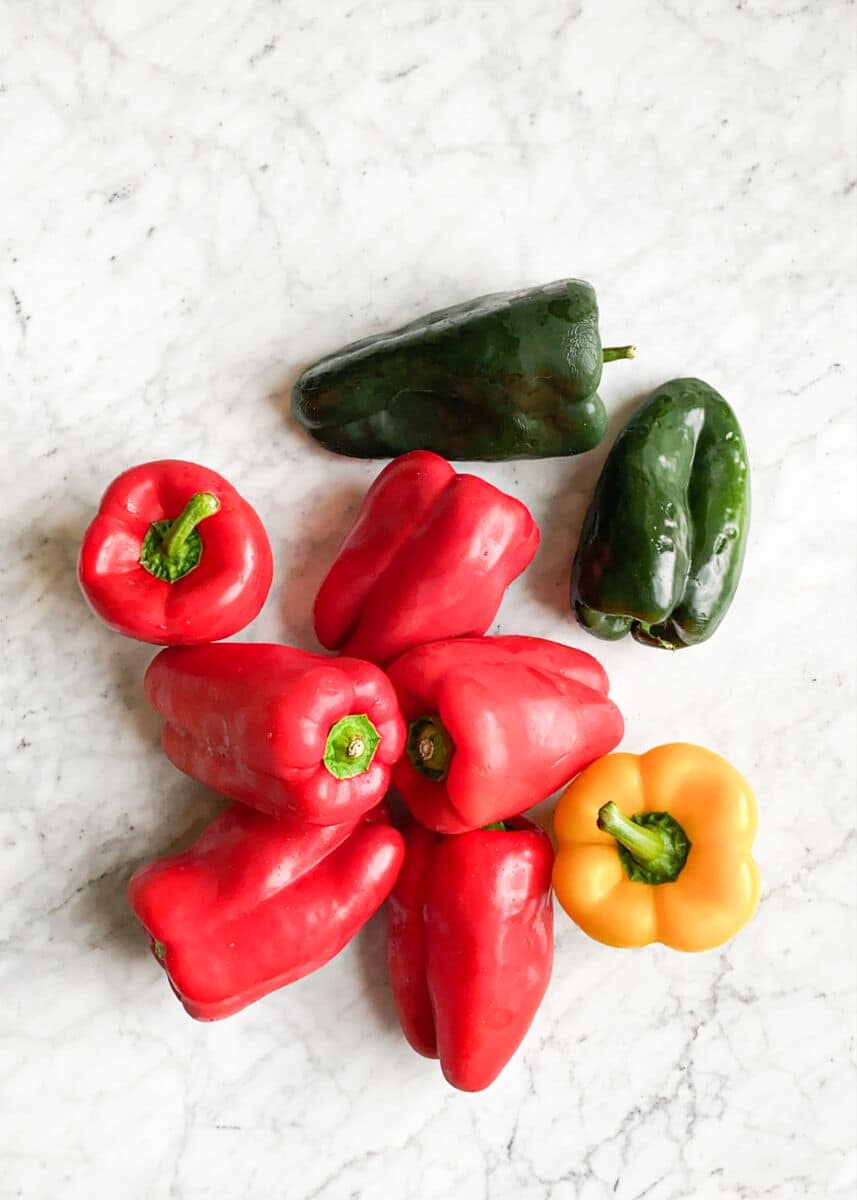
Pumpkin
Can you freeze pumpkin? YES.
- Pumpkin is best frozen either cubed raw OR cooked and pureed. To freeze raw cubed pumpkin, lay the cubes in a single layer on a parchment-covered baking sheet to freeze for about an hour (this prevents them from freezing together in clumps), and then transfer them to a Ziploc or container of your choice. To freeze cooked pumpkin, puree it after cooking and portion it into either muffin tins, ice cube trays, or directly onto a parchment-covered baking sheet (using a 1/2 cup measuring cup) to freeze; once completely frozen, transfer to a freezer bag for easy storage.
- Note: frozen pureed pumpkin is great for chilis, soups, curries, and lasagna.
Radicchio
Can you freeze radicchio? NO.
- Radicchio is best eaten ASAP.
Radishes
Can you freeze radishes? YES.
- Radishes are best frozen once washed, dried, chopped, and blanched. Once blanched, dry completely and transfer to a freezer-safe bag for storing.
Rhubarb
Can you freeze rhubarb? YES.
- Rhubarb is best frozen raw and chopped. Thoroughly wash and dry the stalks and then chop into 1-inch pieces. Once chopped, lay the rhubarb in a single layer on a parchment-covered baking sheet to freeze for about an hour (this prevents them from freezing together in clumps), and then transfer them to a Ziploc or container of your choice.
- Note: frozen rhubarb works really well in desserts like this crisp.
Romaine Lettuce
Can you freeze romaine lettuce? NO.
- Romaine lettuce is best eaten ASAP.
Russet Potatoes
Can you freeze russet potatoes? YES.
- Russet potatoes are best frozen after being (at least) partially cooked. Either roast or blanch chopped russet potatoes before freezing, or freeze baked whole russet potatoes (stuffed or plain).
- Note: mashed potatoes freeze well and may just need a bit of cream or milk added to them when reheating.
Sea Vegetables
Can you freeze sea vegetables? YES.
- Sea vegetables are best frozen after a quick blanch. Once blanched, cooled, and dried, store in an airtight container in the freezer.
- Note: the consistency will likely change once defrosted, so use in dishes (like soups) where appearance and texture don’t matter.
Snap Peas
Can you freeze snap peas? YES.
- Snap peas are best frozen raw. Wash, dry, chop the ends, and then cut into 1-inch pieces. Add the chopped snap peas to a freezer-safe bag and squeeze out as much air as you can before freezing.
- Note: frozen snap peas are great in stir-fries, soups, or roasted.
Snow Peas
Can you freeze snow peas? YES.
- Snow peas are best frozen raw. Wash, dry, chop the ends, and then cut into 1-inch pieces. Add the chopped snow peas to a freezer-safe bag and squeeze out as much air as you can before freezing.
- Note: frozen snow peas are great in stir-fries, soups, or roasted.
Spaghetti Squash
Can you freeze spaghetti squash? YES.
- Spaghetti squash is best frozen once cooked. Roast the spaghetti squash and let it come to handling temperature before scooping out the “noodles” and transferring to a freezer-safe bag. Squeeze out as much air as you can and freeze.
Spinach
Can you freeze spinach? YES.
- Spinach is best frozen raw. Wash and dry the spinach leaves before storing in a freezer-safe bag or airtight container.
Sweet Potatoes
Can you freeze sweet potatoes? YES.
- Sweet potatoes are best frozen after being (at least) partially cooked. Either roast or blanch chopped sweet potatoes before freezing, or freeze baked whole sweet potatoes (stuffed or plain).
- Note: mashed sweet potatoes freeze well and may just need a bit of cream or milk added to them when reheating.
Swiss Chard
Can you freeze swiss chard? YES.
- Swiss chard is best frozen raw. Wash, chop, and let dry completely before freezing.
Tomatillos
Can you freeze tomatillos? YES.
- Tomatillos are best frozen washed with the husk removed. You can freeze tomatillos either whole or sliced. If freezing sliced tomatillos, lay the tomatillo slices in a single layer on a parchment-covered baking sheet to freeze for about an hour (this prevents them from freezing together in clumps), and then transfer them to a Ziploc or container of your choice.
- Note: frozen tomatillos are perfect for this salsa.
Tomatoes
Can you freeze tomatoes? YES.
- Tomatoes are best frozen once washed and chopped in half or into fourths. Once chopped, lay the tomatoes in a single layer on a parchment-covered baking sheet to freeze for about an hour (this prevents them from freezing together in clumps), and then transfer them to a Ziploc or container of your choice.
- Note: because tomatoes are packed with water, they get quite mushy once thawed, and are best used in soups, stews, and sauces.
Turnips
Can you freeze turnips? YES.
- Turnips are best frozen either cooked and mashed or roasted. Pack the mashed or roasted turnips in an airtight container and freeze.
Turnip Greens
Can you freeze turnip greens? YES.
- Turnip greens are best frozen raw. Wash, chop, and let dry completely before freezing.
Yams
Can you freeze yams? YES.
- Yams are best frozen once cooked.
Yellow Squash
Can you freeze yellow squash? YES.
- Yellow squash is best frozen once chopped and blanched. Once cooled and dried, transfer squash to a freezer-safe bag or an airtight container.
Yukon Gold Potatoes
Can you freeze Yukon gold potatoes? YES.
- Yukon gold potatoes are best frozen after being (at least) partially cooked. Either roast or blanch chopped Yukon gold potatoes before freezing.
- Note: mashed potatoes freeze well and may just need a bit of cream or milk added to them when reheating.
Zucchini
Can you freeze zucchini? YES.
- Zucchini is best frozen once chopped and blanched. Once cooled and dried, transfer squash to a freezer-safe bag or an airtight container.
We hope this fruit + vegetable freezer index is a super helpful resource for you that you can come back and reference time and time again!
Just for You
Solution Articles
Want more ideas like this?
